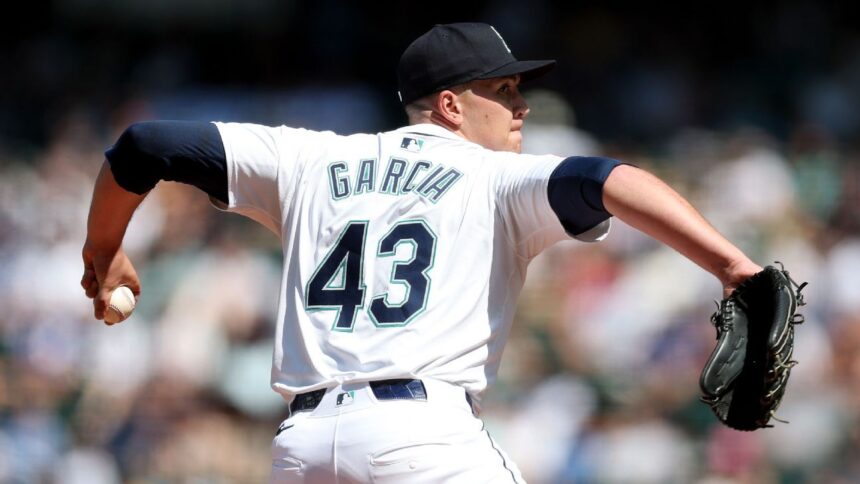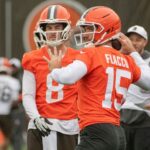The MLB trade season has entered a phase of high activity, with contending teams looking to reinforce their rosters for the final stretch and rebuilding teams focused on accumulating young talent with an eye to the future, all before the deadline of Thursday at 6 p.m. ET.
While the moves are being finalized, fans are likely to form their own opinions about MLB veterans joining new teams, but it’s much more complicated to assess the impact of minor league players who also change destinations.
Here’s our ranking of the most outstanding prospects who were traded during July, organized by levels according to Future Value ratings so you can place them on a list of the top 100 MLB prospects or in your team’s development system ranking.
This list will be updated with the top prospects who change teams with each new agreement, so come back to see which stars of tomorrow are moving this month.
Level 40+ FV
- Brandyn Garcia, LHP, Arizona Diamondbacks
Acquired from the Seattle Mariners in the deal for Josh Naylor.
Selected in the eleventh round of the 2023 draft by Texas A&M, Garcia was an unexpected prospect in the Seattle system who established himself as a starter in 2024. This season, he was moved to a full-time relief role, leading to his debut in the Major Leagues earlier this month.
It has a mechanic that relies heavily on the upper body, with a very short extension and an almost sidearm release that, however, generates a lot of velocity, with his fastball reaching 100.4 mph this season and staying between 95-98 mph with his sinker plus. He also mixes an 88-90 mph cutter and an 84-86 mph sweeper, both plus pitches. The improvement in Garcia’s fastball command and the continued effectiveness of the cutter against right-handed hitters are key for him to become a late-inning reliever.
- Griffin Herring, LHP, Colorado Rockies
Acquired from the New York Yankees in the Ryan McMahon deal.
Herring signed for $800,000 after being selected in the sixth round of the 2024 draft. He only made one start in two seasons at LSU, but showed starting qualities. Through 16 appearances as a starter this year, pitching at both Class A levels, that theory has largely held true.
His 88-92 mph fastball reaches 94 and looks to be an average to marginal pitch, while his slider is above average and his changeup (which should be used more often) also shows flashes above average. He will ascend to the 40+ FV level with a little more performance and/or a strong finish/promotion in Double-A.
- Wellington Aracena, RHP, Baltimore Orioles
Acquired from the New York Mets in the deal for Gregory Soto.
Aracena was a low-profile international signing, receiving a $70,000 bonus in 2022 from the Dominican Republic. He stayed at 90-94 mph during his first two professional seasons, then his velocity exploded in 2024 to 95-98, reaching 100 mph. This year it has been even a bit higher, staying at 96-99 and reaching 101 mph at age 20 as a starter in Class A.
The reason he isn’t ranked higher is that his command is below average to the point that his possible professional outcome is as a reliever. His fastball also plays below its velocity at the moment due to his command issues and his higher arm angle, which creates a non-ideal plane and a cutting action on the pitch. His 89-95 mph slider (possibly a cutter and a slider that run together) is nasty, a clear plus pitch, while his changeup is rarely used and is rudimentary.
The raw ability here is impressive and Aracena is young and athletic enough to have another year or two to prove he can start, but he also has potential for late-inning relief if that doesn’t work. Aracena will move to the 40+ FV level with a little more command, developing a legitimate changeup or simply staying afloat in terms of performance as a starter in High-A.
- Ashton Izzi, RHP, Arizona Diamondbacks
Acquired from the Seattle Mariners in the deal for Josh Naylor.
Izzi was a classic projection right who signed for $1.1 million after being selected in the fourth round of the 2022 draft from an Illinois high school.
He has met that projection, as his average fastball velocity has increased from 93.1 to 94.0 to 94.5 in his three professional seasons. His four-seam fastball is a solid-average pitch, while his slider can become average with slightly better locations and his sweeper is an above-average, perhaps plus pitch.
The problem is Izzi’s sinker; although it has a good combination of velocity and movement, it is too centered in the zone and has been punished by hitters, being used almost as much as his four-seam fastball. He also doesn’t use his changeup much, but he probably should, especially as he reduces his sinker. With some progress in his combination and locations, this is a number 4 starter package, but Izzi is more of a long reliever as he is currently constituted.
- Andrew Hoffmann, RHP, Arizona Diamondbacks
Acquired from the Kansas City Royals in the deal for Randal Grichuk.
Hoffmann was a 12th-round selection from Illinois in the 2021 draft who was traded to the Royals in 2022 and finished the season in Double-A, exceeding pre-draft expectations. He was seen as a potential back-end starter at the time, but transitioned to a full-time short relief role this season on his way to making his Major League debut.
His mid-90s fastball is a solid-average offering that plays up due to its funk and deception, and his primary weapon is a plus changeup that projects well to the bottom of the zone. His slider is a clear third pitch and is marginal, which is why he was moved to the bullpen to focus on using his two best pitches. With better fastball locations, Hoffmann could move from middle relief to the late innings.
Level 35+ FV
- Clayton Beeter, RHP, Washington Nationals
Acquired from the New York Yankees in the deal for Amed Rosario.
Beeter was a second-round pick in the 2020 draft and has slowly descended down the scale from starter to reliever to becoming a full-time reliever for the first time in 2025. He is 26 years old and has five major league appearances under his belt, but Beeter is still in Triple-A for now due to his walk rate: 7.2 per 9 innings, including seven walks in his last 8⅓ innings pitched.
Beeter remains a solid prospect due to his 65-grade slider and above-average fastball that reaches 99 mph. The command of his fastball is the variable that, with more progress, could make him a late-inning reliever, but Beeter is a higher-variance middle reliever who needs to avoid walks in Triple-A to get his next opportunity in the Major Leagues.
- Browm Martinez, CF, Washington Nationals
Acquired from the New York Yankees in the deal for Amed Rosario.
Martinez signed for a $130,000 bonus last January and was solid last summer in the Dominican Summer League before having a great repeat season in the league this year, with an OPS of 1.139 driven by higher contact rates.
There is still a wide range of potential outcomes for Martinez as an 18-year-old playing in the lowest level of the minor leagues, but the key here is that he has above-average bat control and pitch selection at the plate, possibly the two most important things to demonstrate at the lower levels.
He is also a solid-average runner who has 34 stolen bases in his career, and that speed could allow him to stay in center field. There is still some physical projection given his age, but his power projects to remain below average, so staying in center would be key to his long-term value.
- Josh Grosz, RHP, Colorado Rockies
Acquired from the New York Yankees in the Ryan McMahon deal.
Grosz is a possible number 5 starter/swingman type with some feel and deception from his abruptly quick mechanics. He throws a 92-95 mph dead zone fastball with heavy tail that plays around average, an above-average changeup, and a marginal slider.
He has a more difficult path to being a solid Major League player if he can’t stick as a starter because most teams prefer an intermediate reliever to have an above-average breaking ball to get right-handed hitters out.
- Cameron Foster, RHP, Baltimore Orioles
Acquired from the New York Mets in the deal for Gregory Soto.
Foster is a 26-year-old long reliever who sits 93-96 and reaches 99 mph from a high slot (overall an average Major League pitch). He also mixes an 86-88 mph cutter (a solid-average pitch), an 81-84 mph slurve (an above-average pitch), and a big looping 75-78 mph curveball (effective as a fourth offering used in certain situations). He’s a versatile and solid back-of-the-roster arm who can be used in multiple roles and should debut this year or next. He needs to be added to the 40-man roster after the season to protect himself from the Rule 5 draft.









